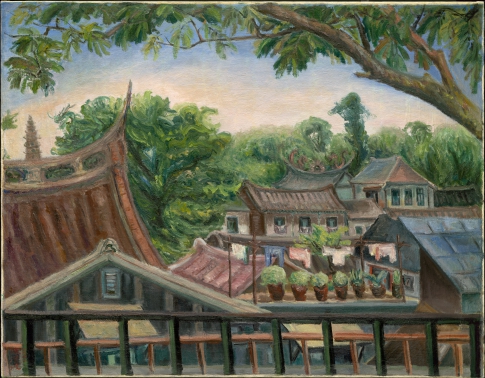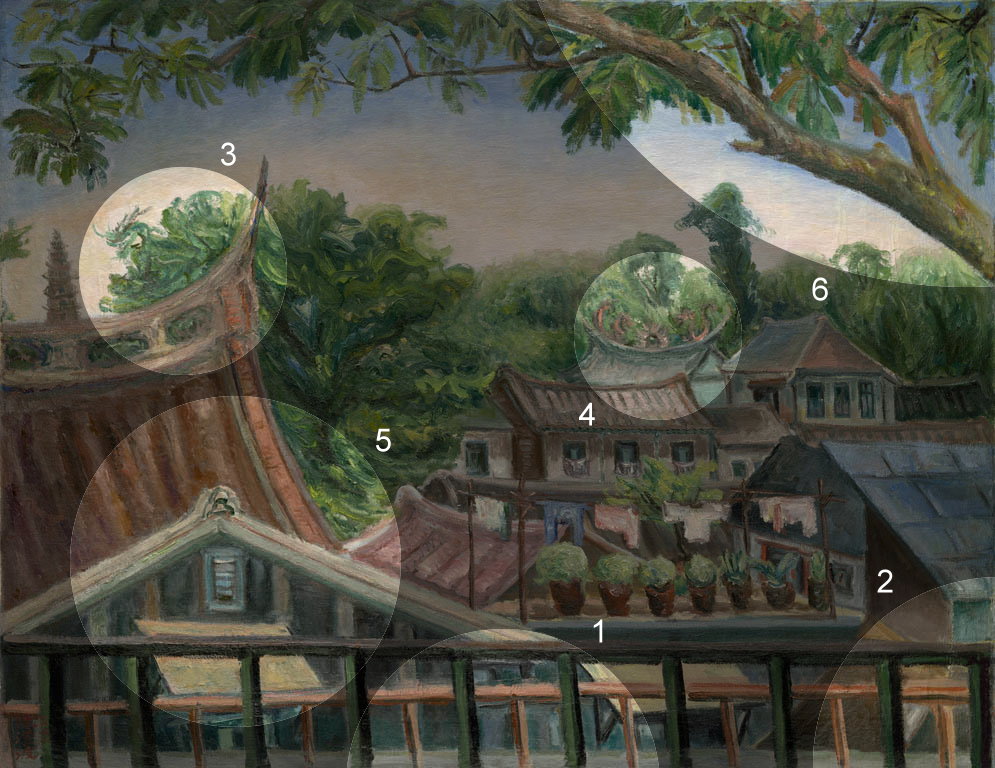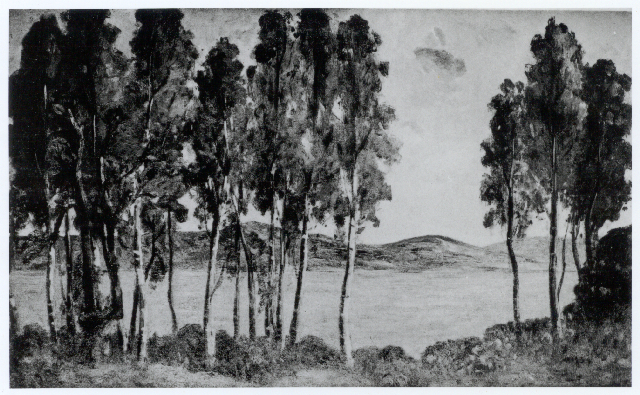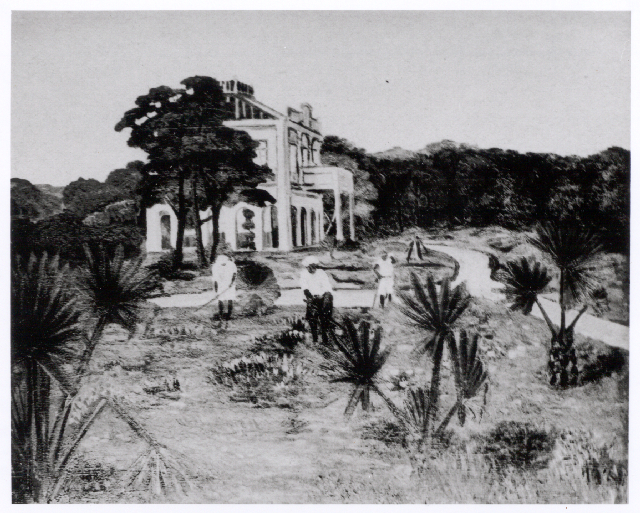初秋
為提供使用者有文書軟體選擇的權利,本文件為ODF開放文件格式,建議您安裝免費開源軟體 ([連結])

初秋
Early Autumn
初秋
1942, 畫布油彩, 91×116.5cm
oil on canvas
画布油彩
城鎮角落的風景裡,幾何線條相互交錯,廟宇的翹脊、木造房舍的山形頂、西洋風味的小屋……各種各樣的建築物,構成了韻律起伏有致的美妙畫面。闊葉樹的枝幹有力地伸展,綠蔭環繞著畫境,即便是初秋時節的南國,依舊表現出旺盛的自然生命力。衣衫靜靜晾曬在木架子上,望著欄杆外的小世界,你是否也感受到安適與悠閒的氣氛呢?
Geometric contours intersect and overlap in this picturesque corner of town. An assortment of architectural structures— neighborhood temples with upswept roofs, wooden homes with pitched roofs, and quaint cottages with Western allure—complement one another, creating a pleasing cadence that flows throughout this peaceful tableau. The branches of a broad-leaved tree stretch powerfully upwards and outwards, encircling the rooftops with lush green vegetation. Although autumn has already begun to set in, this southern Taiwanese scene is still bursting with vitality. Gazing out past the balustrade—past the clothes hung out to dry on the wooden rack—can’t you feel the soothing tranquility of this little world?
街角の風景に交錯する何本もの線―廟宇の屋根に反り返る燕尾脊、日本式木造家屋の山型の屋根、西洋風の小さな家。多種多様な建築物によって、リズミカルで美しい画面が構成されています。力強く伸びる広葉樹の枝、緑陰に包まれた風景、初秋を迎えた南国の、衰えることなく旺盛な自然の生命力が表現されています。木製の竿に干された洗濯物、手すりの外に広がる小さな世界に目をやれば、皆さんものんびりと安らいだ気持ちになりませんか。

1.作畫位置
The artist’s vantage point
作画地点
根據陳澄波後人的回憶,這件作品是在蘭井街故居的陽台上向南方遙望,左側有寶塔的屋脊應是溫陵媽祖廟的背面,右側的枝葉則是種植於後巷的龍眼樹。時移事易,陳澄波故居的形貌已大幅改變,畫中有欄杆的陽台亦已不存。
According to his descendants, Chen Cheng-po painted this work looking southward from the balcony of his old home on Lanjing Street. To the left, the pagoda gracing the ridge of a roof likely belongs to the Temple of the Wenling Sea Goddess, as seen from behind. The branches and leaves shooting forth from the right are those of a longan (dragon-eye) tree planted in the back alley. Over time, Chen’s old home underwent significant changes, including the removal of the balcony and its balustrade which is depicted in this painting.
陳澄波の子孫の記憶によれば、この作品は蘭井街旧居のベランダから南の方を見て描かれた作品です。左側に見える宝塔と屋根の棟は温陵媽祖廟の裏手で、右側の樹木は裏の路地に植えられた龍眼の木でしょう。時の流れとともに陳澄波旧居の外観も大きく変化し、この絵に見える手すり付きのベランダはもうありません。

2.兩件素描
Two sketches
2枚のデッサン
陳澄波所遺留的素描簿裡,有兩件速寫與這幅油畫相關,其中一件應是妻子張捷抱著孩子向欄杆外遙望,另一件則是《初秋》的草稿。仔細比對素描與油畫,可以發現陳澄波在最後完成的作品裡,更動了許多空間配置上的細節。
Within Chen’s extant sketchbooks, there are two pencil sketches which pertain to Early Autumn. One of these portrays a woman, likely his wife Chang Jie, holding a child in her arms, looking out over the balustrade, while the other is the preliminary sketch for this work. Upon close examination and comparison with the final painting, these sketches reveal that Chen made certain modifications with respect to the scene’s spatial configurations.
陳澄波が残したデッサンノートの中に、この油彩画と関係のあるスケッチが2枚あります。そのうちの1枚は子供を抱いた陳夫人がベランダの手すりから外を眺めている様子で、もう1枚は『初秋』の草稿です。このデッサンと油彩画を丹念に比較してみると、最終的に完成した作品は細部の空間配置に何度も変更があったことがわかります。

人物速寫(172)-SB30(40.10-41.7) 約1940-1941 紙本鉛筆 36.5×26.3cm
Figures sketch-SB30(40.10-41.7) ca. 1940-1941 Pencil on paper 36.5×26.3cm
人物のスケッチ(172)-SB30(40.10-41.7) 1940-1941頃 紙、鉛筆 36.5×26.3cm

風景速寫(202)-SB30(40.10-41.7)約1940-1941 紙本鉛筆 36.5×26.3cm
Landscape sketch-SB30(40.10-41.7) ca. 1940-1941 Pencil on paper 36.5×26.3cm
風景のスケッチ(202)-SB30(40.10-41.7) 1940-1941頃 紙、鉛筆 36.5×26.3cm
3.畫作題名
Title of painting
画作の題名
日治時期政府舉辦的美術展覽會裡,「初秋」是常見的作品題名。比如李澤藩、廖繼春、楊三郎等畫家,都曾有描繪初秋時節的風景畫獲得入選。嘗試比較這些作品,你覺得他們想要表現的「初秋」,有什麼相同或相異之處呢?
During the Japanese colonial period, Early Autumn was a common title among the works on display at government-hosted fine arts exhibitions. Artists such as Lee Tze-Fan, Liao Chi-chun, and Yang San-lang all exhibited early autumn landscapes, but each artist portrayed the season in a unique light. Studying these works, what similarities and differences catch your eye?
日本統治時代に政府が主催した美術展では、「初秋」はありふれた題名でした。例えば、李沢藩や寥継春、楊三郎などの画家も、初秋のころの風景画で入選を果たしています。これらの作品を見比べてみましょう。画家たちが表現しようとした「初秋」に共通点や相違点はあるでしょうか。

楊佐三郎,《初秋の湖畔》,1940,第三回府展。中央研究院歷史語言研究所授權。
Yang San-lang, Lakeside in the Early Autumn, 1940, Third Governor-General Art Exhibition.
楊佐三郎,『初秋の湖畔』,1940,第3回府展。

名島貢,《初秋風景》,1940,第三回府展。中央研究院歷史語言研究所授權。
Najima Mitsugu, Early Autumn Landscape, 1940, Third Governor-General Art Exhibition.
名島貢,『初秋の風景』,1940,第3回府展。
4.龍形剪黏
Porcelain jian nian dragons
龍形の剪黏
剪黏是中國南方特有的民間工藝,傳入臺灣之後,成為寺廟屋頂與牆堵的主要裝飾技法。匠師將剪裁後的瓷片黏貼於灰泥表面,藉以創作出各種造型。在這幅畫裡,陳澄波刻意將一只龍形剪黏融入背景的綠蔭裡,你也看見了嗎?
Jian nian (“cut and paste”) is a traditional handicraft which was brought to Taiwan from southern China and is now one of the most prominent forms of ornamentation for temple roofs and walls. Its name comes from the technique by which craftsmen cut and paste pieces of porcelain to a plaster surface, creating different figurines. In this painting, Chen cleverly hid a jian nian dragon in the lush background greenery. Can you find it?
「剪黏」とは、中国南部特有の民間工芸です。台湾に伝わってからは、寺廟の屋根や「牆堵」(寺廟の壁面)の装飾技法として用いられました。剪黏は、切った磁器片を漆喰の表面に貼り付けて、いろいろな模様や形を作ります。この作品中、陳澄波は意図的に龍形の剪黏を背景の緑陰に溶け込ませています。どこに剪黏があるか、おわかりになりますか。
5.雙龍拜塔與雙龍搶珠
Protector dragons
双龍拝塔と双龍搶珠
臺灣廟宇的剪黏有許多不同的造型主題。而出現在這幅畫中的「雙龍拜塔」與「雙龍護珠」,都是正脊頂端常見的辟邪裝飾。七級寶塔與摩尼珠的概念源自佛教,青龍除了具有守衛的作用,同時能帶來雨水,保護寺廟免於火災。
The jian nian artwork decorating Taiwan’s temples features a wide-ranging cast of characters. Certain are more common than others, such as protector dragons which prowl temple roofs to ward off evil spirits. In this painting, two pairs of rooftop dragons guard the Seven-Story Pagoda and the Mani Jewel—both visual representations of Buddhist concepts. The green dragons are bestowed with a special protective power to summon rain in the event of fire to save the temple from destruction.
台湾の廟宇を飾る剪黏には多種類の主題があり、その形も様々です。この絵に見える「双龍拝塔」と「双龍護珠」は、棟の端によくある厄除けの装飾です。「七宝塔」と「摩尼珠」は仏教由来の概念で、青龍は寺廟の守護だけでなく、雨を降らせることもでき、寺廟を火災から守ります。
6.日式建築
Japanese architecture
和風建築
日治時期,隨著許多「內地」移民來臺定居,日式建築也大量出現在島嶼的各個角落。望向圖中這幢建物的側面,可以見到屋脊上的鬼瓦、山牆頂端的氣窗,以及覆蓋牆面的雨淋板。這樣的老屋,在今日的嘉義市街也仍可得見。
During the Japanese era, as more and more “mainlanders” settled in Taiwan, Japanese-style structures began to spring up in large numbers across the island. Within this painting, certain architectural elements are identifiably Japanese. For example, the building in the front-center features an onigawara (ogre-face tile) at its apex, a transom light at its gable, and clapboards covering its exterior walls. Old historic homes such as this can still be seen along the streets of Chiayi today.
日本統治時代、「内地」からの移民が台湾に定住するにつれ、たくさんの和風建築物が台湾各地に建てられました。画中の建物の側面を見ると、屋根の棟には鬼瓦、破風の上部には通風用の窓があり、外壁は下見板張りになっています。この家のような古い和風住宅は、現在も嘉義市内で見られます。
7.樹與構圖
Trees and composition
樹木と構図
安排在側邊的一株大樹,枝葉如傘蓋般遮蔽了天空,這樣的做法時常出現在陳澄波的風景畫當中。延伸向畫面頂端的樹蔭,除了說明「初秋」的自然狀態與在地的生態景觀,在視覺效果上,這樣的前景安排也能製造畫面的深度。
Chen often arranged his landscapes with a large tree on one side of the canvas, its branches and leaves stretching and opening up like an umbrella to obscure the sky. This green shade placed in the foreground, running along the top of the canvas, creates greater depth and expresses the natural state and local ecological scenery of early autumn.
画面の片側に配置された大樹の枝葉が傘のように空を覆っています。この描き方は陳澄波の風景画にしばしば登場します。画面の端に向かって伸びる木陰が、「初秋」の自然環境と、この地の植物の生態を表しています。視覚効果の面では、前景をこのように配置すると画面全体の奥行きを増すことができます。

《農家》,畫布油彩,91×117cm,1934。
A Farming Household, oil on canvas, 91 x 117 cm, 1934.
『農家』,画布油彩,91×117cm,1934。

《長榮女中學生宿舍》,畫布油彩,91×116.5cm,1941。
Chang Jung Girls’ Senior High School Dormitory, oil on canvas,91×116.5cm,1941。
《長榮女中學生宿舍》,畫布油彩,91×116.5cm,1941。
在這兩件陳澄波的作品當中,由畫面側邊向頂端延伸的大樹,除了表現自然風土的特色,同時也能幫助整幅畫製造透視距離。想像一下,若是把大樹從畫面當中移除,這些作品又會變成什麼樣子呢?
Chen framed these scenes with a large tree or trees on one side of the canvas, branches stretching across the top. This arrangement highlights the distinctive natural features of the landscape and creates a sense of depth. Just imagine what these canvases would look like if the trees were not there.
陳澄波のこの2点の作品には、画面右側から上に向かって枝を伸ばす大木が描かれている。自然の風土的特色を表現しつつ、画面全体の距離感を生み出す効果もある。想像してみよう。もしこの大樹が画面から消えたら、この2作はどのように変わるだろうか。
